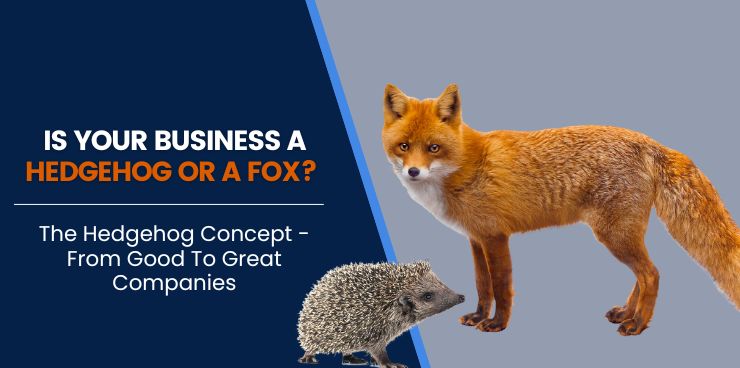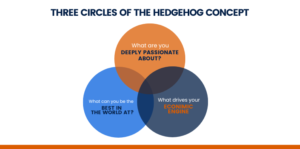Let me first ask you a question. What spirit animal do you think best represents a successful business? A lion because it devours the competition? A horse because it charges forward with determination? A bear for its resilience, ferocity, and adaptability?
The Hedgehog Concept would argue otherwise. You read that correctly, a hedgehog. What’s funny is that you wouldn’t even have considered a hedgehog among your choices if you had one.
According to its proponent, Jim Collins, author of “Good to Great”, the hedgehog is the symbol of successful businesses. Not because a hedgehog rolls into a protective ball to survive the harshest of winters. Instead, among the animal kingdom, only hedgehogs have their head in the game and know their primary direction in life.
How about you? Do you know where your business is going, or more importantly, where it SHOULD be headed? If not, you have to understand this concept.
Jim Collins’ book teaches that the Hedgehog Concept is a principal pillar that helps companies go from good to great. If you’re intrigued as to how, let’s demystify this Hedgehog Concept and discover how it can benefit your business. Keep reading.
 The Hedgehog and the Fox
The Hedgehog and the Fox
Before we dig deeper into what this seemingly absurd concept is about. It’s important to take a step back and analyze its roots for us to understand the idea better. Jim Collins’ Hedgehog Concept was derived from a Greek parable that says:
“The fox knows many things, but the hedgehog knows one big thing.“
In the parable, the fox is seen hunting for prey and it stumbles upon the humble hedgehog. The cunning fox tries all tricks in the book to capture the hedgehog. Sneaking, pouncing, racing but to no avail. On the other end, the hedgehog stays true to its one big thing– rolling into a ball. That’s why each of the fox’s attacks is reciprocated with spines that prick its nose and paws.
Isaiah Berlin, a Russian-British philosopher, used this parable to describe the human race in his essay in 1953. In his essay, appropriately called “The Hedgehog and the Fox,” he divided people into two categories: foxes and hedgehogs.
Berlin argued that foxes pursue many things and are preoccupied with a wide range of interests. In the end, they achieve very little because their thinking is scattered and unfocused. It’s easy to see that foxes are like Jack of all Trades for they are a master of none. On the other hand, hedgehogs focus on a single vision– one goal which they perform and accomplish.
So how does this relate to businesses?
Jim Collins explains that hedgehogs have an unwavering understanding of what they’re good at. This knowledge gives them direction to perfect that skill and be the best in that craft. The hedgehog principle in “Good to Great” asserted that organizations succeed when they can identify one thing they do best.
That one thing or one goal or one aspect is called your Hedgehog Concept.
Pursuing one doesn’t mean you let loose and flunk all other fronts. It’s about devoting your energy and resources to achieving your company’s Hedgehog Concept. Like the hedgehog, that’s how you thrive and survive in this fox-filled world.
Do you want your business to get pricked in the nose, or do you want to dominate your game? Wizard of Sales® can help you find your Hedgehog Concept the same way that I’ve helped others find theirs. All you have to do is book a free call with me and let’s talk about it.
Three Circles of the Hedgehog Concept
The Hedgehog Concept is but one of many principles that Jim Collins coined through his book “Good to Great.” To discover the best companies he mentioned in the book, he exhaustively studied nearly 1,500 companies over four years.
Jim argued that all good-to-great leaders, in one way or another, exhibited the hedgehog principle. This means that they steered the ship to the waves of the Hedgehog Concept. Conversely, the rest of the 1,500 business leaders tended to be foxes– scattered, diffused and inconsistent.
You can’t be a fox in a tough and competitive business climate such as this one. That’s why mastering the Hedgehog Concept is imperative for success. Doing so begins with understanding the three core principles (circles) that make up the Hedgehog Concept.
Before we explore each circle that completes the Venn diagram above, there’s something we should first clarify. The Hedgehog Concept is NOT a goal, a strategy, an intention or a plan to be the best company ever. The Hedgehog Concept is a way to understand what aspect your business can be the best at.
Knowing this distinction is crucial in your goal to scale your company from good to great.
Why?
Because every organization wants to be the best at something. But only a few fully understand their potential to be the best (and not the best) at a particular endeavor. That’s the clarity and reality that you first need to accept and embrace.
With that out of the way, let’s now explore each circle that completes the Venn diagram.
#1 What Are You Deeply Passionate About?
Have you ever wondered what gets you up in the morning and what keeps you working late? Knowing what excites, drives and motivates you is a critical element in this 3-piece puzzle. This is called your passion, and finding it is the foremost step to forming your Hedgehog Concept.
Only through passion will you have the grit and intensity to become the best in your field. Despite hardships and adversities along the way, your passion will see you through. Moreover, when you’re passionate about something, it’s not just a job anymore– it becomes your life’s purpose and mission. Fulfilling a certain role no longer feels heavy on your shoulders because you’re in love with what you do.
How then can you apply this information to your business? Simple.
To start with, go back to square one. Ask yourself what you’re deeply passionate about. Make sure to dig deep and dissect every layer and find your genuine core passion. Next, ask your employees what they are deeply passionate about as well.
- What do employees value the most in their work?
- What type of work inspires them and keeps them from feeling burnt out?
- What kind of work do they feel most enthusiastic about?
These questions will lead to their passions.
#2 What Can You Be the Best in the World At?
In this next step, you should already know what you and your employees are passionate about. It’s time to ask yourselves if your passion aligns with being the best in the world at something. This means not just being good, but truly excelling and standing 600 ft. above your competition.
Now, ask yourselves these questions:
- What does your company excel at compared to others?
- What sets your company apart in the industry?
Finding out what your organization does absolutely best is your distinguishing factor. Don’t worry, there’s no shame if your passions don’t align with what you’re good at. Your aim is to find whatever your business does better than anyone else. Even if you’re extremely good at something but you’re number two, this shouldn’t be at your Hedgehog Concept.
One helpful technique to find the answer is using a S.W.O.T. analysis. This analytical process lists down all the strengths, weaknesses, opportunities and threats surrounding your business. Among your strengths, find the one that beats all other competitors in your industry.
Note: If you cannot find one, that’s okay. Look for that one strength where you have the undeniable potential to be number one.
It’s important to accept that you cannot be the best in everything. You will also have weaknesses in your business and it’s okay to be completely honest with them. Despite those shortcomings, having a complete grasp of your strengths is far more important.
#3 What Drives Your Economic Engine?
The Hedgehog Concept is not merely a tool to find your best armaments. Since Jim’s principles are anchored to businesses, the economic aspect of your business is also heavily considered. This is the focus of the third circle: to find out which business operations influence your bottom line.
Understanding your economic engine requires you to know how to generate sustainable cash flow and profitability. You can call this your “economic denominator” which means the single measure with the greatest economic impact on your business. The economic denominator is defined as your “profit per X” wherein “X” talks about the money-generating endeavor.
For example, in the residential home service industry, you can view it in terms of the following economic denominators:
- Profit per AC unit installed
- Profit per heater repaired
- Profit per drain fixed
- Profit per preventative maintenance appointment run
- Profit per roof replaced
- Profit per roof repaired
…etc.
Whatever it is, the key is finding the activity that brings in the most money to your company. This element will have the most prominent and sustainable impact on your overall success as a business.
The Overlapping Circles
Once you’ve pieced all three circles together, take a look at their overlaps. At the center of it all, you have what Jim Collins calls the Hedgehog Concept. It’s the one big thing that you are really good at, passionate about and income-generating. The centerpiece will be your north star that guides your business’s strategies.
When you stick to this strategy, the likelihood of success becomes higher. Why? Because you operate on a single-pronged goal that everyone is good at and passionate about doing.
For example, say your company is an HVAC business. Let’s presume you and the people within your business are passionate about sustainability. You also figured that you are unrivaled in installing energy-efficient HVAC systems for commercial buildings. This could become the main spiel of your Hedgehog Concept that drives your sales to different heights.
Of course, the Hedgehog Concept is much more complicated than my example above. You will definitely take your time figuring this out within your company. But trust me, all these analyses will be worth it in the long run.
“What You Can (And Cannot) Be the Best at in Your Company”
When Jim Collins first devised the Hedgehog Concept, the inspiration behind it was Wells Fargo.
Warren Buffet, despite his reservations in the banking industry, has a staggering $290 million investment in Wells Fargo. In Buffer’s words, he said:
“They stick with what they understand and let their abilities, not their egos, determine what they attempt.“
But Wells Fargo has not always been successful. What ultimately led to their success is when the Hedgehog Concept became their company’s mantra. Prior to this, they operated in their banking activities much like Citicorp, and they stunk up the place. Because of this, they had to face the reality and ask themselves the most brutal questions:
- What can we do that is potentially better than other companies in our industry?
- What are the things that we cannot do better than other businesses?
Finally, they figured out the answer. They also elucidated another crippling reality that freed them from their slump:

In light of this realization, Wells Fargo halted their international operations and focused on the U.S. instead. They then turned their attention to the one thing they’re good at – running a bank like a business.
Their solution is not really rocket science. If you’re not good at something, why do it? And if you’re really good at something, pour your heart out and attention into perfecting that craft.
That is the simple reality that the Hedgehog Concept reveals to people. To not waste time doing something you’re not good at, and instead, hone in on what you excel in.
Does that mean you shouldn’t diversify and increase the range of services you offer? Of course not. It does, however, mean that you should have a clear understanding of what to focus on first. Once you have perfected the art and science of one activity, you can now do something else.
Do that other thing while still maintaining the same level of perfection in the previous one.
Be a Hedgehog in Business
To reiterate, the hedgehog principle is not your end but the means to your end. By knowing the centerpiece of your circles, you are guided on what to prioritize for the success of your business. This will enable you to stand 600 ft. above your competition and make your brand distinctive in a Sea of Sameness.
The better you are at performing a task, the more capable you become at serving customers at the highest level. Think about it. Highly satisfied customers breed loyalty, which then leads to better word-of-mouth marketing, repeat customers and positive reviews. In other words, being a hedgehog slowly forms the foundation that makes a highly successful enterprise.
At the end of it all, you become the leader in your industry and bring success to your company.
The question is: do you want to be a hedgehog or a fox in your industry? If you want to be a hedgehog, it will take some time to get there. Unless, of course, you have an expert to walk your company through the process. Thankfully, with vast experience helping companies, Wizard of Sales® can guide you. Book a call and we’ll go from there.


 The Hedgehog and the Fox
The Hedgehog and the Fox